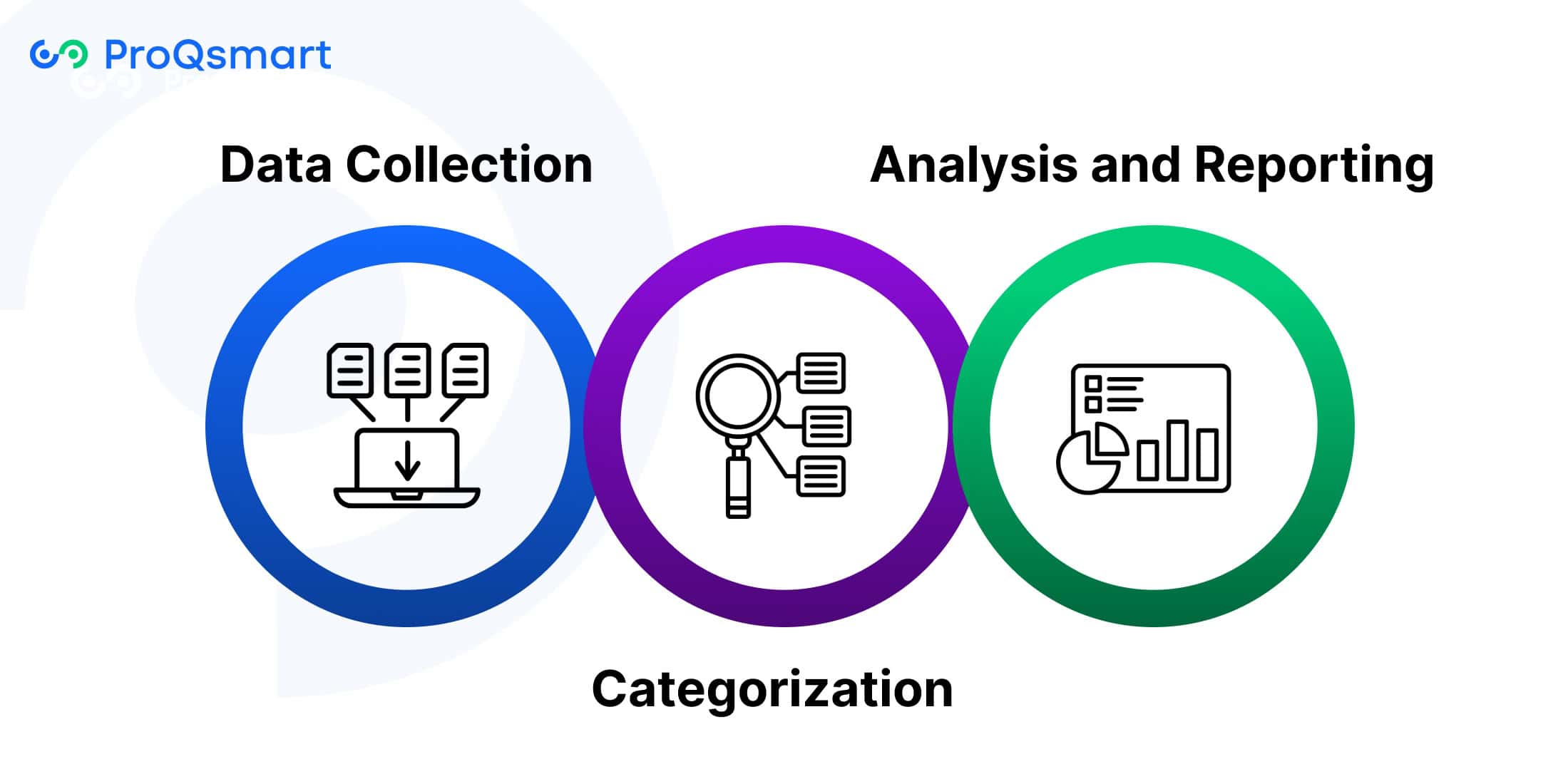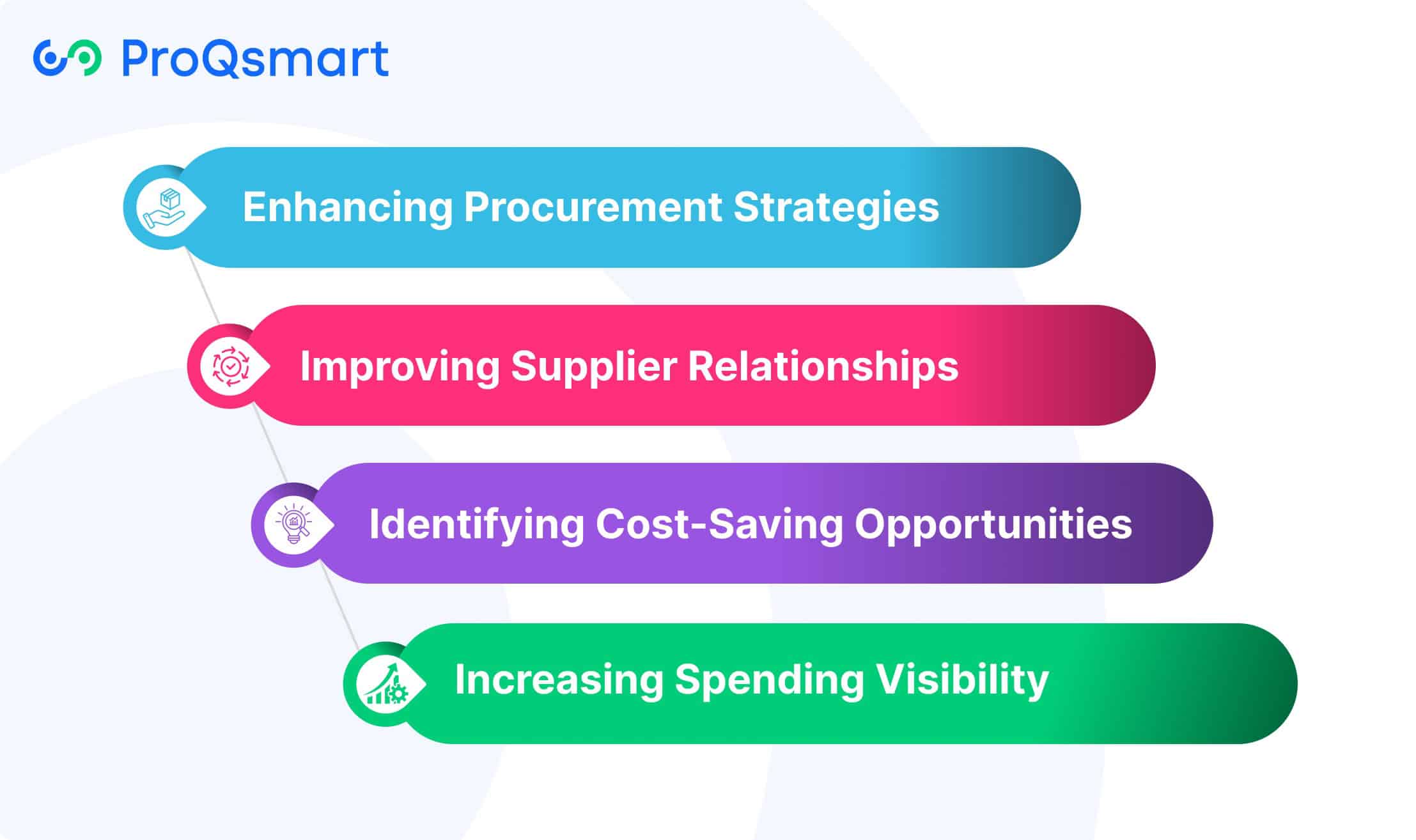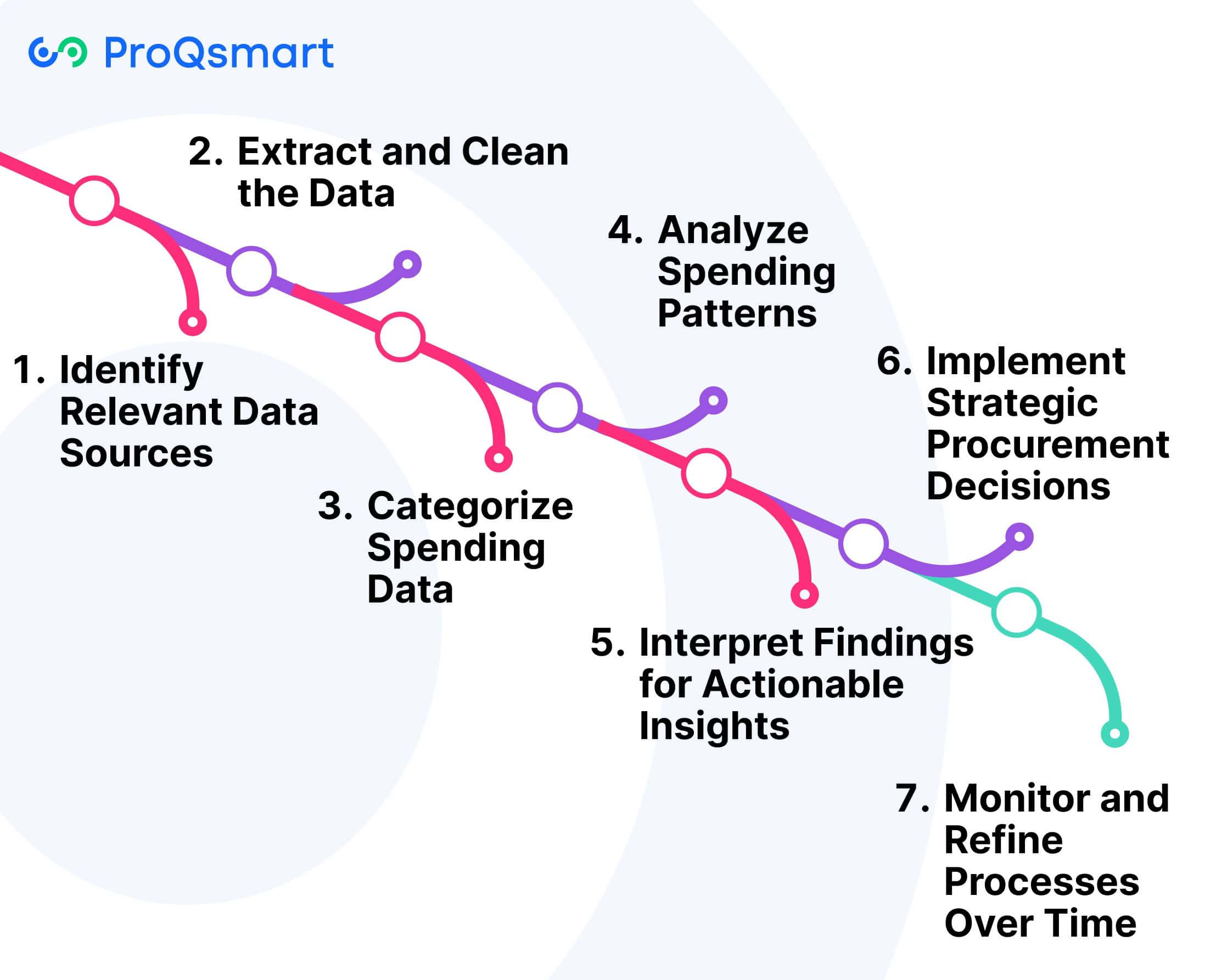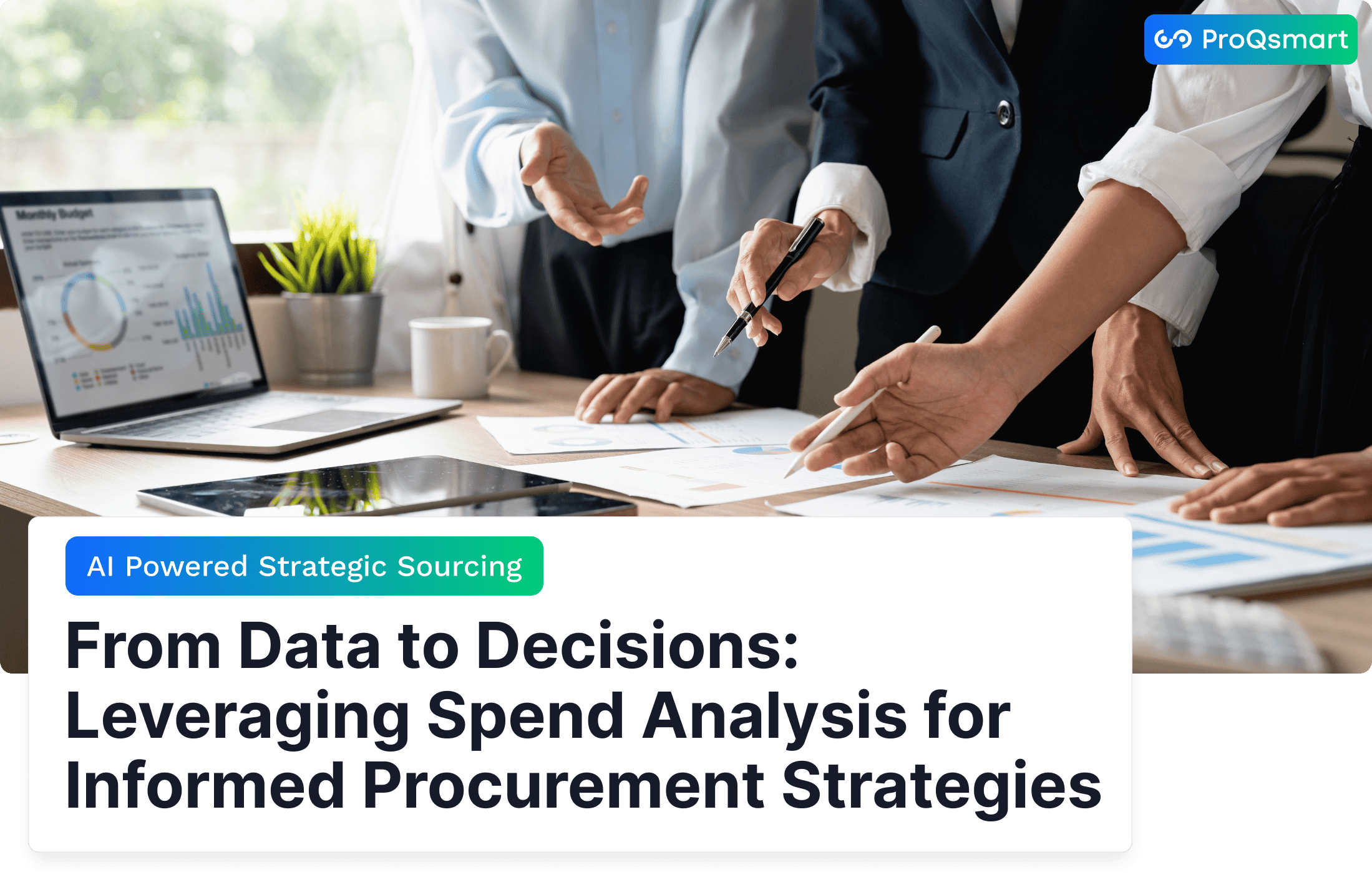Spend analysis is the first step in the spend analysis process, looking at an organization’s spending patterns. It uncovers opportunities to improve efficiency. It informs smarter decision-making and classifies spending into categories while finding patterns.
This enables you to evaluate supplier performance, then find obvious opportunities for cost savings and strategic improvements. In addition to better budgeting and avoiding the “supplier surprise,” it helps organizations comply with procurement policies across government.
When done with a systematic method, spend analysis can reveal significant savings that were previously obscured and increase visibility into all procurement activities. This tool is invaluable to any organization seeking to advance their supply chain on the equity spectrum.
It enables them to realize sustainable growth in an increasingly competitive marketplace. By integrating spend analysis into procurement strategies, procurement professionals are better equipped to spend dollars in ways that contribute to broader business objectives. In this article, we will delve into the intricacies of spend analysis, exploring its benefits, best practices, and how it can be leveraged to drive strategic sourcing success.
What Is Spend Analysis?
Spend analysis, as the name implies, is a systematic way to collect and organize spending data. This process makes for better procurement decisions and increases high-level financial efficiency. Companies analyze their spend to understand where they are spending their money. That clarity allows them to make smarter and more strategic decisions that support their overall goals.
This tool is tremendously important to establish a baseline for spending behaviors. Perhaps most importantly, it enables you to monitor supplier performance and identify potential opportunities for cost savings and process improvements.
Key Components of Spend Analysis

Data Collection
Spend analysis begins with pulling the data from multiple different systems/ERPs within the organization. This can be data from Enterprise Resource Planning (ERP) systems, accounts payable (AP) systems, e-procurement platforms, and expense management systems. Collecting this data helps to get the full picture of every transaction, both direct and indirect spend. This comprehensive spend visibility is crucial for understanding how to optimize procurement costs.
Direct spending also covers the raw materials used in manufacturing. Indirect spending usually includes less glamorous items such as office supplies and professional services. Without comprehensive data collection, it’s impossible to know what’s working and where every dollar is going.
Categorization
After spending data is collected, it needs to be classified. You can organize spending into categories that make sense to your organization, allowing you to compare apples with apples. This detailed spend analysis enables organizations to spot trends, like repeat maverick spending—in other words, purchases that violate procurement policies.
Categorization allows organizations to spot trends, like repeat maverick spending—in other words, purchases that are in violation of procurement policies. For example, unsanctioned software subscriptions may remain under the radar without appropriate categorization.
Analysis and Reporting
Communicating these insights in a succinct, digestible manner makes it possible for the public, policymakers, and other stakeholders to respond with conviction. As 73% of organizations adopt some form of intelligent automation, leveraging a robust spend analysis solution becomes a critical catalyst for leading this change.
In conclusion, effective spend management not only streamlines procurement processes but also enhances overall business performance by providing clarity on financial data and procurement options.
Importance of Spend Analysis in Procurement

Enhancing Procurement Strategies
Spend analysis is a powerful tool for informing and improving procurement strategies. It helps make strategic sourcing decisions by identifying high-spend areas, consolidating suppliers, and maximizing value through better negotiation.
For example, a business that has access to its spend data can find opportunities to negotiate bulk discounts with preferred suppliers. This strategy consistently results in major savings. Metrics including spend by category, supplier performance, and payment terms can identify inefficiencies and inform where to allocate your budget.
Spend analysis is all about informing procurement teams to work smarter. This allows them to harmonize with other key business priorities such as sustainability and risk management, creating a united front to drive organizational success.
Improving Supplier Relationships
Transparency and trust are the keys to strong supplier relationships, and both are fortified through the use of spend analysis. By identifying strategic suppliers, procurement teams can focus on building collaborative partnerships and negotiating better terms.
For example, analytics can identify suppliers who have a track record of providing quality materials on schedule, allowing firms to foster better partnerships. By encouraging transparency with spend data, you can cultivate open communication built on trust, minimizing disputes and leading to longstanding partnerships that serve both of your interests.
Identifying Cost-Saving Opportunities
Spend analysis identifies cost-saving opportunities by identifying overlapping or unnecessary spending. Identifying opportunities comparing spending patterns against industry benchmarks can help identify areas for improvement, including renegotiating contracts or improving procurement processes.
AI tools make this process even easier, automating data analysis and increasing efficiency. A $5 billion revenue business can easily save hundreds of millions in procurement. By implementing spend analysis practices, they’re able to lower costs from $19.5 million down to only $8.5 million.
Increasing Spending Visibility
Whether in the public or private sector, visibility into spending patterns is critical for proactively managing budgets and avoiding rogue spending. AI-driven, advanced analytics tools further enhance visibility and provide real-time decision-making insights.
This allows companies to easily analyze trends and make data-driven decisions. With increased transparency, spend analysis helps improve compliance, cut maverick spending, and keep data clean and accurate, adding up to a healthier bottom line.
How to Conduct Spend Analysis

As the foundational element of strategic procurement, a spend analysis initiative can help organizations cut through the noise, providing a clearer picture of their total spend. This spend analysis tool comprises a series of defined steps that ensure transparency and offer actionable insights, driving cost savings and enhancing operational efficiencies.
1. Identify Relevant Data Sources
Start by identifying where data will come from including ERP systems, accounts payable systems and procurement software. Combining data from expense management systems or tools used by departments gives you a full picture.
Centralizing all this information into one central repository ensures that everyone has convenient access to it. This method reduces data silos, which frequently complicate complex spend analysis.
2. Extract and Clean the Data
This is because raw data is usually full of redundancies, errors, or inconsistencies. Going through the steps of cleaning data removes these problems.
In this case, standardizing formats, like unifying currency or naming conventions, goes a long way in increasing precision. Ensuring data integrity is key, as any inconsistencies, such as mismatched entries, can completely derail the analysis.
3. Categorize Spending Data
Group the spending into clearly defined categories like operational expense, capital expenditure, and indirect costs. Standardization makes it much easier to benchmark and helps to ensure consistency.
Tools such as spend cubes further add depth by visualizing the data across multiple dimensions, such as supplier, category, and time. This method will help you identify patterns more easily.
4. Analyze Spending Patterns
In particular, robust analytical tools are crucial to uncovering anomalies and spending trends. Dedicated visual dashboards help make the complex data simple and visual, identifying trends that can be matched with your KPIs.
For example, if supplier costs are high, it might point toward opportunities to consolidate spend.
5. Interpret Findings for Actionable Insights
Turn analytical findings into actionable insights. Focus on the insights that will help you achieve your objectives, such as reducing costs or consolidating suppliers.
Provide a summary of findings to all stakeholders, allowing for data-driven next steps.
6. Implement Strategic Procurement Decisions
Take action based on your findings to improve your sourcing strategies. Shift procurement’s focus from cost-cutting to long-term, sustainable business objectives.
Tools such as ProQsmart take this process a step further with AI-powered insights, transparency, and automated workflows that facilitate more efficient collaboration.
7. Monitor and Refine Processes Over Time
Frequent reviews and a stakeholder feedback loop in spend management help adapt strategies to changing market conditions and business priorities. Keeping a watchful eye on spending metrics helps you spot new savings opportunities and guarantees long-term success.
Benefits of Spend Analysis in Procurement
Through a comprehensive spend analysis initiative, organizations can gain powerful insights into their procurement expenditures, leading to tremendous cost savings, enhanced supplier relationships, and reduced risks. This process creates a ripple effect, enabling their businesses to make more informed, data-backed decisions that drive sustainable operational and financial returns.
Cost Reduction and Efficiency Gains
Spend analysis helps you find areas where you can consolidate purchases or eliminate waste, like redundant purchases or unused stock. A deeper analysis might find unnecessary suppliers providing the same items. This finding presents a huge opportunity to reduce the vendor pool.
This consolidation does more than make management of both easier, it helps to maximize negotiation power, resulting in more favorable contract terms and overall cost optimization. Efficient spending helps the bottom line by cutting fat and finding new opportunities to invest scarce resources where they’ll do the most good.
With the help of these highly actionable insights, businesses can confidently make future budgets, manage spending, and stop the leakages of potential savings, allowing for long-term financial health.
Enhanced Risk Management Techniques
By gaining greater visibility into their spend through spend analysis, procurement teams can better identify risks beforehand, such as supplier financial instability or compliance gaps. Active monitoring of supplier performance helps to prevent any disruption related to supply chain.
Additionally, flagging third-party risks, from cyber attacks to negative environmental impacts, bolsters our overall resilience. Spend analysis identifies unusual spending patterns, such as maverick buying, helping to ensure that procurement efforts remain in compliance with enterprise policies.
Tools such as ProQsmart further strengthen this by automatically checking compliance and highlighting risk in real-time.
Improved Supplier Performance Evaluation
Analyzing spend data offers a clear view of supplier performance, enabling organizations to assess reliability and adherence to contract terms. Developing metrics from spend analysis fosters accountability and supports better vendor selection.
For example, evaluating delivery times or quality standards strengthens supplier partnerships, boosting mutual growth.
Better Decision-Making Through Data Insights
Data-driven procurement decisions are the building blocks of smarter sourcing strategies. Spend analysis offers actionable insights that help organizations align procurement goals with broader business objectives, enabling companies to allocate resources more efficiently.
Specialized platforms such as ProQsmart promote data literacy through AI-driven analytics, workflow automation, and improving the connection between procurement and available budgets.
Best Practices for Effective Spend Analysis
Use Advanced Analytical Tools
Using an advanced analytics tool, like ProQsmart, uncovers a much richer, granular understanding of the spending data. Automation not only eliminates costly manual errors, it accelerates the processing of data, providing organizations with real-time visibility into their expenditures. Companies should consider looking at AI-powered spend analysis software like ProQsmart, designed to use AI to make procurement more efficient and effective.
ProQsmart automates documentation, improving auditing and compliance, while building better supplier relationships and keeping procurement focused on budget with real-time tracking. With its transparency and supplier performance monitoring features, you can be confident in spending comprehensively.
Ensure Data Accuracy and Consistency
Accurate, timely, and comprehensive data forms the basis of any successful spend analysis. This will ensure data accuracy is upheld through regular validation and cross-checking across multiple sources.
Establishing data governance policies is another way to maintain data integrity and consistency. Without clean data, you can’t derive actionable insights and you’ll increase maverick spending, which is when purchases go around procurement policies.
Collaborate Across Departments
Collaboration between procurement, finance, and other internal teams enhances spend analysis by providing different perspectives. Cross-functional insights promote alignment of spend analysis with organizational priorities and stakeholder objectives.
Setting up a cadence of communication helps to create a collective understanding that leads to collaborative decision-making.
Regularly Review and Update Data
Regular data scans are key to reflecting new and changing spending patterns. Planning to refresh consistently keeps your insights fresh and accurate, helping you build better forecasting and budgeting.
Regular updates build stakeholder trust in the analysis, motivating action to make better decisions.
Future Trends in Spend Analysis
Spend analysis has changed dramatically, and continues to change, thanks to new technologies and the changing focus of procurement professionals. New tools such as automation and AI are certainly changing the landscape and future of spend analysis.
We’re just now starting to see a greater trend towards sustainability and the visionary nature of real-time data insights. These trends do more than make everything faster and easier — they provide procurement professionals with intelligent, actionable information that allows for data-driven, strategic decisions.
Role of Automation and AI
Automation is changing the game of spend analysis by minimizing manual work and increasing precision. Tasks like data categorization, supplier segmentation, and invoice matching can now be handled swiftly, enabling teams to focus on strategic planning.
AI-powered tools, like machine learning algorithms, go much further to identify hidden spending patterns and cost-saving opportunities. AI, for example, can help identify anomalies within tail spend, which we estimate digitization could eliminate by 5–10% per year.
Tools such as ProQsmart combine these capabilities, providing on-demand, data-driven insights to help you make smarter, more informed decisions. By implementing these types of solutions, organizations can improve supplier collaboration, automate sourcing workflows, and ensure compliance, all without the headache.
Integration with Predictive Analytics
When spend analysis is paired with predictive analytics, it adds a much more forward-looking perspective to the approach that procurement strategies can take. Predictive models use historical data to predict future spending trends, allowing private sector organizations to better plan budgets or reduce their exposure to risk.
Firms that use predictive analytics in conjunction with accounts payable software or customer relationship management (CRM) platforms benefit from a marked advantage in their forecasting, further enhancing procurement performance.
Growing Focus on Sustainability Metrics
Sustainability has become an important factor in the procurement process. Spend analysis tracks environmental and social metrics so that organizations can make informed responsible sourcing decisions.
ProQsmart’s real-time tracking keeps you in line with your budgets while tracking your suppliers’ performance against your sustainability goals.
Real-Time Data Insights for Procurement
Having access to real-time data obviously increases procurement’s ability to be more agile. Now organizations can react faster to any changes in their suppliers or shifts in market dynamics, minimizing the risk of disruptions.
Spend analytics has become a key priority for companies. Through proactive investments in technologies like ProQsmart, they save millions in costs, increase transparency and improve their procurement decision-making.
Conclusion
Spend analysis is the key to making more strategic, intelligent procurement decisions. It’s a solution that powers spend analysis to discover hidden savings opportunities, get more value from supplier relationships, and increase efficiency. By examining spending patterns, teams get a clearer picture that informs better decisions and more cohesive strategies. All in all, with the right tools and practices, spend analysis is no longer only a process—it creates tangible value for businesses.
Part of staying ahead is being aware of emerging trends such as AI-driven tools and real-time data. These new technologies streamline the process, saving time and improving accuracy, providing teams with a distinct competitive advantage.
To develop a roadmap for substantive improvements in your procurement operations, consider integrating advanced spend analysis tools like ProQsmart. This innovative platform can help you unlock the full potential of spend analysis, driving more efficient and cost-effective procurement strategies.
Ready to transform your procurement processes and drive better outcomes? Book a demo with ProQsmart today!




